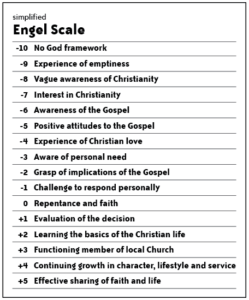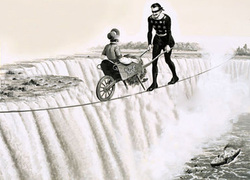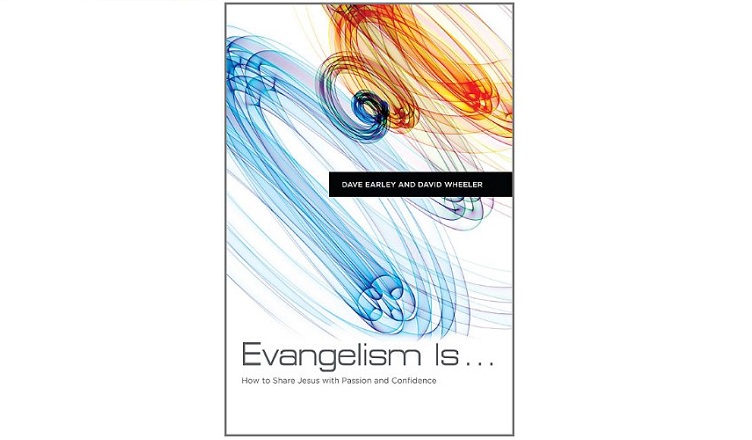 I have mixed feelings about this book.
I have mixed feelings about this book.
On the one hand I felt the author’s understanding of the gospel was deficient, I disagree with them over the kind of faith the gospel seeks and the role of good works in the future judgment.
On the other hand, this book is jam packed with great encouragement, stories and helpful tips that will inspire its readers to get out there and share their faith.
Because most of the content in this book is great and the great need for evangelism, I give it the thumbs up with some constructive comments.
- Link: Amazon
- Length: 368
- Difficulty: Easy-Popular
- Topic: Evangelism
- Audience: Mainstream Christians
- Published: 2010
I found the book quite readable, with lots of stories to keep our interest. Their heart is in the right place. They also have a good sense of humor as one can see from the hyped up introduction to their book;
This is more than just another book; it is your guide to the great adventure of doing your part to change the world for Jesus Christ. Let us warn you: these 40 chapters are dangerous. They will transform your life . They will set you on a course that will cause you to see and treat people differently than you have ever seen them before. They will make you a spiritual change agent, a difference maker, an impact player for Jesus Christ. They can even make your name known in hell. (38)
This post is one of my book reviews.
Contents
As you may have noted from the introduction the book consists of 40 chapters. The book is not written to be read in large slabs. Rather it is more suited to be used as a devotional book. I think reading a chapter once a day or even better once a week would serve its readers well, since they could then reflect on what was said through the week. Each chapter has an application section at the end, with memorable quotes and references for further reading.
The chapter sections are loosely organised around motives, meaning, manner and methods. Four ‘M’’s, I suspect they are baptists.
1 Motive
Chapter 1 – Evangelism is Joyfully Intoxicating
I found the first chapter one of the most discouraging and it was only a foretaste of several chapters to come. It’s because the authors gospel is soterian, through and through. (For a explanation of the soterian gospel see here). Sin and salvation have a greater emphasis in this book than Jesus and him being King.
One of the shortcomings of the soterian gospel is that it is not easily found in the scriptures. Consequently many who advocate the soterian gospel, if they want to articulate it from scriptuire are forced to jump around from one verse to another, stringing along the four steps they believe is the gospel. They do this because it cannot be found in a single spot and certainly not in the apostles gospel preaching such as Acts 2.22-36, 3.13-18, 10.38-43, and 13.27-33.
This chapter is one of a few in this book which highlights this problem. It jumps from Rom 3.23 to Rom 3.10-12 to Rom 6.23 to Rom 10.9 to Rom 10.13.
In later chapters we see they quite like the sinners prayer, encouraging their readers to pray through this list once they are taken in.
- Are you a sinner?
- Do you want forgiveness of sins?
- Do you believe Jesus died on the cross for you and rose again?
- Are you willing to surrender your life to Jesus Christ?
- Are you willing to invite Jesus into your life and into your heart? (255)
Note the repeated emphasis in ‘you’. The soterian gospel is all about us and to a lesser extent on Jesus.
Throughout the book they will refer to the gospel as ‘Jesus’ death, burial and resurrection for our sins’.
We shared the story of the death, burial, and resurrection of Jesus for our sins . We also shared the plan of salvation (by admitting your sins, believing on Christ for salvation, calling on His name to save you, and committing your life to Him). (311)
Which on the surface of it looks good, because it matches 1 Cor 15.3-5. However note the ending, ‘for our sins’ and his emphasis on the ‘plan of salvation’. This expression is the target of Scot McKnight in his King Jesus Gospel book (review here).
Mathematically ‘(a + b + c) * x’ is quite different from ‘(a * x) + b + c’.
Their definition of the gospel leads one to believe the gospel hinges on sin, atonement. Consequently both Jesus’ burial and resurrection are viewed as having a sin bearing / atoning benefit. I beg to differ.
Chapter 4 – Evangelism is the Supreme Challenge of This Generation
One the good side however I found this chapter really inspiring as they compared Christians in evangelism with US Marines.
Marines pride themselves in upholding core values of honor, courage, and commitment. The marine motto is Semper Fidelis, Latin for “always faithful.” Marines are to remain faithful to the mission at hand, to one another, to the Corps, and to country . In boot camp marines are taught that becoming a marine is a transformation that cannot be undone. Once made, a marine should be forever faithful to live by the ethics and values of the Corps. There is no such thing as an ex-marine. …
The reason we have dedicated ourselves to training young adults is that we believe God is calling out a new generation of Christian marines, sold-out followers of Jesus who are the church’s first line of defense. They are willing to be first on the scene, first to help, and first to fight. They are ready to respond to the need of the hour by spreading the gospel by land, air, sea, or any other means available . They are young men and women of honor, courage, and commitment. (31)
Christian life and particularly evangelism is a battlefield. Christian’s need to be motivated, disciplined, to work together and be courageous in evangelism. I found this analogy quite encouraging and a helpful way of understanding our mission and place in the world.
Chapter 8 – Helping People Become Good Enough
Soon afterward the book will jump again to junk food. Protestant merit theology. In this chapter they run through an example where someone was asked by God why he should let him into heaven.
Being saved or not being saved is a matter of having the right type of righteousness, the type that makes you good enough for God. God is holy. He is sinless, righteous, and perfect. In order to relate to Him, we need a perfect level of holiness, sinlessness, and moral perfection as well. In other words, we need a pure righteousness. (61)
Having written a page of future judgement and salvation I found much of this unbiblical, discouraging and unhelpful. Good works, repentance and perseverance are all necessary for receiving a righteous verdict when Jesus judges us according to works. This is just plain wrong and a perversion of the gospel. See here for a brief comment on how to evangelise while still encouraging non-believers to do good.
2 Meaning
Chapter 10 – A Process Leading to an Event
The soterian gospel is on occasion accused of failing to lead its converts into a life of discipleship. The authors are aware of the need for a lifetime commitment, not just a one off decision, so I thought this chapter helpful.

Marriage is a serious commitment. It is supposed to last a lifetime. No reasonably sane, secure American girl chooses to marry someone she does not know fairly well. Therefore people will spend months or even years getting to know all they can about a person and finding out if that person can be trusted. In a similar way, trusting Jesus as your Lord and Savior is a significant commitment, which the Bible likens to marriage. Jesus is called the Bridegroom (Eph 5: 25– 27; Rev 19: 7– 9). It will last throughout eternity. (78)
The chapter, as the title suggests is about the whole process of conversion. They pull out the Engel scale for good measure. Overall I found their focus on the various stages of evangelism quite helpful.
Chapter 13 – Being a Missionary, Not a Mission Field
This chapter encourages its readers to get out there and be involved in mission. We either sit in church and receive, or get out there and bring others into the kingdom. This book helps its readers to feel obligated to be involved in evangelism.
One of the strengths of this book is the quality of its illustrations. Charles Blondin (1824-97) was a French tightrope walker and acrobat. He became famous in America for crossing over the Niagara gorge on a tightrope. On one occasion he crossed with a wheelbarrow and afterwards invited people to volunteer themselves to get in the wheelbarrow so they could cross with him. The authors use this as an analogy for the trust and commitment required to trust Jesus.

If you were in the crowd that day, you could not get across the Niagara by being pretty good or joining a church but only by having the faith to get in the wheelbarrow. In the same way, you do not receive eternal life merely by being pretty good or joining a church but only by having the faith to get in Jesus’ wheelbarrow . You must have the faith to trust in Him to be the complete and total payment for your sins. (106)
While the illustration is quite vivid and demonstrative of their wordsmithing, it breaks down of course because receiving eternal life is inseparable from the process of salvation (again look at what the scriptures say; e.g. Mt 25.31-46; Rom 2.6-11; Gal 6.7-10). Trusting in Jesus entails obeying his commands, repenting of sin and persevering just as much as it does receiving the benefits of the cross. We trust in Jesus in all he says and does. Not just the cross.
Chapter 17 – Cooperating with the Holy Spirit
The authors are theologically aware enough to know that in evangelism we depend on God, through His Spirit to work in the hearts and minds of the listeners and that it is the Spirit who guides us into opportunities to share the gospel.
Recognizing that anytime a person gives his or her life to Jesus Christ it is never a solo operation. At least three persons are always involved: (1) the nonbeliever who hears the gospel and receives Jesus, (2) the person who shares the gospel with the nonbeliever, and (3) the Holy Spirit who applies the gospel to the understanding of the nonbeliever. (145)
This chapter reminds us of the importance of prayer in evangelism, the need to be sensitive to the movement of the Spirit and lastly to give God the glory for our success.
3 Manner
Chapter 22 – A Lifestyle
Another chapter demonstrating the breadth of their knowledge is this one which touches upon some themes associated with the missional church movement. Seeing God’s incarnation in Christ as the model for our involvement in this world and reaching peoples different from ourselves.
As God personally brought the Good News to mankind, so we are to “incarnate” Christ to the lost, that is, to penetrate, (pitch our tent) significantly into the lives of the non-Christian for the purpose of not only verbalizing the Gospel but also to live it before them. As Christ lives His life through the believer, they see the “visible expression of the invisible God” as well as hearing the Word of salvation. (184)
As you can see from the quote the authors are aware of the multifaceted nature of evangelism. They encourage lifestyle evangelism and role modelling just as they insist upon verbalising the gospel.
Chapter 23 – Winning Three Battles so Jesus Can Win the War
This is a great chapter which in a similar manner to the Engel scale breaks down necessary steps to bring someone to Christ. They highlight three main steps.
- Win them to yourself.
- Win them to your church.
- Win them to Christ.
I found the ‘win them to yourself’ section particularly helpful.
As you begin to win people to yourself , you should elicit from them several “preconversion decisions” about you:
- He is OK.
- I’d like to know him better.
- I feel comfortable with him. He accepts me.
- I want to find out why he is so different.
- It seems that he gets his outlook on things from the Bible.
- He’s a Christian, but he’s OK.
- Being a Christian sure has its advantages.
- I like his friends . I envy their confidence. I like his church. It seems relevant.
- Looking at the Bible might be interesting someday. 7 (190)
Sadly afterward they let themselves down with the sinners prayer.
Dear God, I admit that I have sinned. I admit that I do not deserve eternal life. I believe that Jesus never sinned. I believe that He died to pay for my sins. Right now , I call on Jesus to be my Lord and Savior. I choose to commit the rest of my life to following Him as my King. With God’s help, from this moment on, I will do everything He asks me to do. (193)
4 Methods
Chapter 35 – Asking for a Response
One aspect of evangelism which I have struggled with in the past and am now coming to grips with is asking for a response. Perhaps I was put off by my peers who argued asking for a response is part of the gospel message. I continue to disagree with this, but recognise that after the gospel is preached the audience ought to be called to respond.
Often the hardest challenge related to sharing Christ is asking for a response to the gospel. We can make friends with lost people. We can serve them with the love of Jesus. We can be proficient at memorizing various evangelism approaches. But a point comes when we need to extend an invitation to trust Christ and ask for a response. (287)
I felt this chapter was quite good.
Chapter 37 – Creating Opportunities for Gospel Conversations
Another missional church point is that evangelism works best in community. That is not-yet Christians best come to faith when they are exposed to multiple people in the church and through a variety of positive experiences. Evangelism is a team effort.
In this context they speak about contextualisation. Adapting gospel methods in order to make it relevant to the hearing culture and removing as best we can barriers to them hearing and understanding the gospel.
One of the most effective approaches in evangelism is the process called contextualization. Contextualization is the adaptation of evangelistic methods into a culture without compromising the essential truths of the gospel. It is simply learning to communicate the message so that it can be understood clearly by the recipients in that culture. (302)
(For a detailed explanation of contextualising the gospel see Jackson Wu’s excellent paper here.)
Recommendation
Overall I found the book very readable and I can’t see any problem with the wider Christian audience understanding the contents of this book and learning from it.
The best thing about this book that I came away with is that it really pumps up its readers to get involved in evangelism. The church is under threat every generation of extinction. The challenges facing the reproduction of the church are growing. We need to man up and get out there. Our Christian cultures need to become more and more focussed on mission and evangelism.
This book is very engaging. There are no boring chapters in this book. Whether through the use of stories and illustrations or just good wordsmithing, this book will keep you reading it and hanging on for more.
The content of the book is wide ranging. They are obviously very experienced in gospel ministry and its complexity. I thought this was highlighted quite well by their references to theology, statistics, missional concepts, contextualisation, community and the qualities and motives of an evangelist.
As I said in my overview the chief letdown of this book is they hold to a soterian gospel. Their gospel is hinged on sin, atonement and salvation. With little to no emphasis on telling the story of the gospel, declaring Jesus Lord and calling for allegiance. Their gospel proclaims Jesus as saviour, not Lord. They do not make use of the apostles gospel sermons in Acts.
They incorporate the standard Protestant polemic against good works for judgment in their gospel. Works-righteousness / perfection / merit theology. In this they fail to note how good works are involved in the process of salvation and part of the basis for Jesus’ judgment according to works. Therefore they reinforce false teaching on human responsibility in salvation.
Overall however, the authors display a great heart for the lost and this comes through in the whole book. Despite the misgivings I have regarding their gospel message and their soteriology, I recommend this book.
Copyright © Joshua Washington and thescripturesays, 2017. All Rights Reserved.





